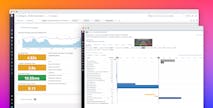What is Frontend Monitoring?
When designing applications, engineers need to understand how users will experience the application across a wide variety of scenarios. For example, a website built as a single-page application may react differently on certain browsers or devices, and teams may need to walk through all of these scenarios. At the same time, teams also need to monitor their applications to ensure each part is behaving as expected. Once an application is in production, errors and performance issues may occur and teams need to quickly troubleshoot to prevent a broken digital experience. The process of proactively testing an application and monitoring user experiences in real time is called frontend monitoring.
Frontend monitoring, or digital experience monitoring (DEM) as referred to by analysts, is a critical part of any monitoring strategy as it helps organizations develop applications that offer the best possible user experiences. Frontend monitoring consists of proactive and reactive monitoring tools, including browser and mobile real user monitoring (RUM), session replay, synthetic monitoring, and mobile application testing.
With so much business conducted digitally now more than ever, delivering a fast, available, and functional application to the end users directly impacts the revenue of a company. While frontend monitoring can be challenging, reducing user errors and proactively improving application performance pays off. According to Twilio’s 2023 State of Customer Engagement Report, “Investment in digital customer engagement increased revenue by 90% on average, up from 70% last year.”
What Are the Main Types of Frontend Monitoring?
Frontend monitoring is split into two categories: proactive and reactive.
Proactive monitoring, which includes synthetic monitoring and mobile application testing, focuses on simulating users’ browser, mobile, and API interactions to make sure that the workflows of interest are functioning as expected. By simulating experiences across multiple browsers or device types, developers can catch and fix issues before the end users get a chance to experience them.
Reactive monitoring, which includes browser and mobile RUM and session replay, is focused on capturing actual users’ interactions with your application. This type of monitoring provides you with performance and user behavioral data to help you understand how users are experiencing your application and identify any opportunities for enhancing the user experience.
By using proactive and reactive monitoring together, organizations can resolve anticipated problems with their applications and find unexpected points of frustration that users are experiencing in the real world. It takes both proactive and reactive monitoring tools to assemble a comprehensive frontend monitoring solution.
How Does Frontend Monitoring Work?
Each method within the frontend monitoring toolkit works in its own unique way. Proactive monitoring through synthetic tests works by sending simulated requests to your applications and services from different browsers, devices, and locations around the world. To learn more about how synthetic tests work and function, read more in our Datadog Knowledge Center article on Synthetics Monitoring.
By contrast, reactive monitoring is designed to capture and analyze the ways users interact with existing applications. RUM works by capturing user interactions in an application and correlating those sessions with performance data such as Core Web Vitals, errors, resources, and long tasks from the web or mobile application.
Session replay takes frontend monitoring a step further by offering visual replays of your users’ browsing experience so that you can easily spot and reproduce any user errors. With extra configuration, RUM data can be correlated with backend metrics and traces to quickly find the root cause of an issue and expedite troubleshooting. By tracking performance data based on end-user activity, developers can gain a complete picture of their application health in real-world scenarios—not just predetermined scenarios covered by synthetic testing.
Who Should Use Frontend Monitoring?
Frontend and mobile developers at all stages of the development cycle can benefit from adopting frontend monitoring. A few use cases for specific development teams are:
Error troubleshooting: Using RUM and session replay, developers can troubleshoot frontend errors with full context and track them over time across versions.
Performance/availability monitoring: Using synthetics, RUM, session replay, and mobile application testing, developers can test and monitor the performance of web pages and mobile applications, including user sessions, views, and actions, as well as remediating poor performing Core Web Vitals.
Behavior monitoring: Using RUM and session replay, developers can capture real users’ interactions with their applications to better understand the user experience and identify any opportunities to enhance it.
What Are the Challenges of Frontend Monitoring?
Frontend monitoring has become increasingly more difficult and crucial. With constant updates, changing technology frameworks, and users coming in from a variety of browsers, devices, and locations, fully monitoring and optimizing the frontend requires a range of tools, which could lead to tool sprawling. However, this is not a problem if all the tools are part of a unified platform and are seamlessly integrated with one another.
Another challenge is that solutions like RUM may provide a picture of user errors and frustrations but may not illustrate the root causes. This can be remedied by connecting RUM to application performance monitoring for full-stack visibility and connecting errors directly to their causes.
What Features Should Users Look for When Choosing a Frontend Monitoring Solution?
When choosing a frontend monitoring solution, teams should consider a provider that offers a variety of proactive and reactive tools in a unified platform. This prevents unnecessary context switching between multiple providers and having to onboard multiple tools.
Key features to look out for are:
- Synthetic monitoring:
- Codeless recorder for test creation
- API, multistep API, and self-healing browser tests
- Diverse network protocols
- Various managed locations and ability to set up private locations
- Out-of-the-box dashboards
- Real user monitoring:
- Performance metrics (e.g., Core Web Vitals, load times, errors, resources)
- Error tracking
- Feature flags
- Alerting
- Session replay:
- Pixel-perfect replays
- Correlation with backend traces
Learn More about Frontend Monitoring
Datadog offers a unified platform for frontend monitoring tools. Learn more about Datadog RUM, Session Replay, Synthetic Monitoring, and Mobile Application Testing. For more information about Datadog frontend monitoring products and features, learn about Datadog’s Digital Experience Monitoring suite.




